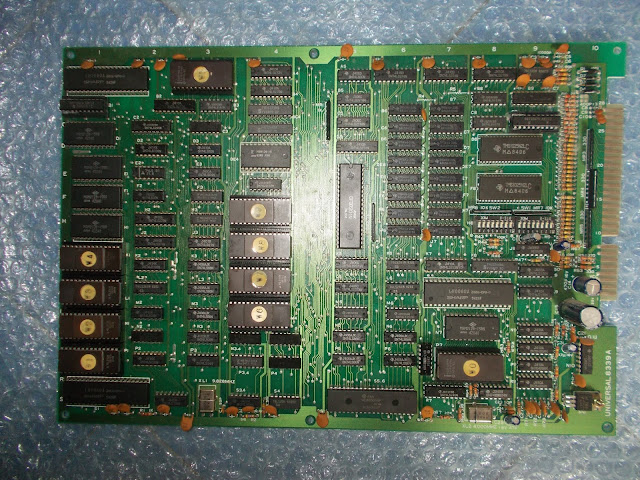Game booted up but displayed with the only RED color, BLUE and GREEN were missing at all :
The logic probe confirmed that signals were both stuck HIGH:
I traced them back to emitter of two NPN (BC337 type) transtitors :
I noticed that pinout of transistor was adapted to the PCB footprint, this probably because manufacturer didn't have the right part or did it for costs saving.A closer inspection revealed that the base and collector (tied to VCC) legs of the BLUE and GREEN transistors were shorted each other causing stuck signals.Clearing the shorts restored the correct colors, in this way I was able to better see what was going on.The game had issue with both sprites and backgrounds :
The sprites are generated by the custom ASIC marked '52' which was previously reworked and repaired in some pins:
I reflowed it but this didn't lead to great improvements, the sprites were still scrambled.Relevant data are stored in ten 4Mbit MASK ROMs (pin to pin compatible with 27C400 EPROM) :
Pressing down the PCB in the highlighed area of above picture restored the sprites hence there could be a bad contact somewhere.I probed each MASK ROM with my oscilloscope and found a floating address line on pin 1 (A17, the higher address line) of the one @9Y :
I run a jumper wire from this pin to pin 1 of the near device (address bus is shared among all sprites MASK ROMs) and I got all sprites properly rendered but, obviously, backgrounds were still glitched :
Tilemap data are stored in three 4Mbit MASK ROMs :
Checking these devices I found again a broken connection between two address lines, I promptly patched it with some wire :
This made the trick and all the graphics were fully restored.I was about to close this repair when, playing some games, I noticed that some audio samples were missing:
Here's how it should sound compared to a MAME recording:
All audio samples are generated by a couple of OKI MSM6295 ADPCM IC :
Checking their analog outputs with an audio probe revealed that the missing samples were properly generated but then lost somewhere before reaching the main amplifier.Always with my audio probe I started to "listen" to various points of analog audio circuit narrowing the area where fault lied.While doing it I came across to this :
The positive lead of a 10uf 16V electrolytic capacitor was detached from body interrupting the audio signal.Replacing the capacitor gave the missing audio samples back and fixed board completely.Repair accomplished.














































